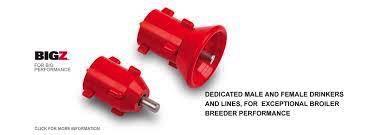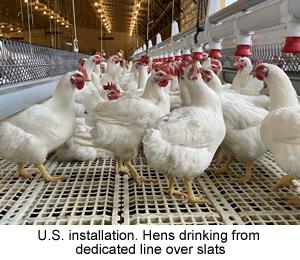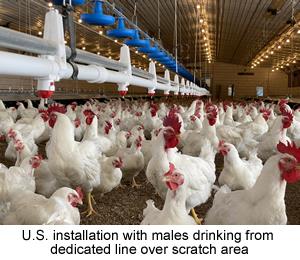 Ziggity Systems designed a nipple-type broiler-breeder watering concept with dedicated male and female watering lines that takes into consideration the difference in height of the genders.
Ziggity Systems designed a nipple-type broiler-breeder watering concept with dedicated male and female watering lines that takes into consideration the difference in height of the genders.
The concept was evaluated in an installation at DanHatch, a specialized broiler egg producer located in Oster Sottrup in southern Denmark. A single line adjusted to the comfortable drinking height of the males was suspended slightly off-center over the scratch area. Hens consumed water only from their drinker lines adjusted to an appropriate height over the slatted area. They were unable to drink from the male line. Male and female lines were fitted with newly designed drinkers specific to beak capacity of the respective genders to optimize actual consumption and to avoid spillage.
 |
 The study period extended over 41 weeks. The test flock comprised 5,500 females and 440 males in a compartment equipped with a dedicated male drinker line fitted with Ziggity Big Z drinkers and female lines with specially designed Big Z shielded drinkers for hens. Results were compared to five adjacent flocks of approximately similar size using a conventional arrangement comprising shared common lines with drinkers fitted with catch cups located over the slats and adjusted to the height of the hens.
The study period extended over 41 weeks. The test flock comprised 5,500 females and 440 males in a compartment equipped with a dedicated male drinker line fitted with Ziggity Big Z drinkers and female lines with specially designed Big Z shielded drinkers for hens. Results were compared to five adjacent flocks of approximately similar size using a conventional arrangement comprising shared common lines with drinkers fitted with catch cups located over the slats and adjusted to the height of the hens.
The results from the flock with the dedicated male line as compared to the comparison flocks indicated:-
- A reduction of 10.1 percent in male mortality. This would imply less need for spiking and possibly a higher level of selection at transfer.
- A numerical improvement in uniformity was determined among males in the single test flock. Weights of males at 40-weeks ranged from 9.37 lbs. to 9.55 lbs. The comparative weights from the five comparison houses ranged on average from 9.41 lbs. to 10.31 lbs.
- The test flock produced 2.4 more settable eggs per hen compared to the flocks with conventional drinker lines. This was due to fewer eggs laid on the litter, and less soiling of floor eggs. Litter was drier in the test house than the houses with conventional drinkers as hens drank only from their lines above the slats. Functional males remained in the scratch area since they were supplied with morning feed and water ad lib.
 The initial trial in Denmark demonstrated the proof of the concept of a dedicated male drinker line. Obviously it will be necessary to confirm the technical and hence financial benefit of retrofitting breeder houses with a male drinker line under U.S. housing and management conditions currently in progress. Differences in cost per chick hatched, attributed to a presumed improvement in the number of settable eggs per hen housed and enhanced hatchability should provide a beneficial 5-year discounted return over the additional cost of the installation. The concept of dedicated male drinker lines should be subjected to structured evaluation in the U.S. and Latin America with sufficient replication under commercial conditions to provide a statistically supported justification for adoption by the Industry.
The initial trial in Denmark demonstrated the proof of the concept of a dedicated male drinker line. Obviously it will be necessary to confirm the technical and hence financial benefit of retrofitting breeder houses with a male drinker line under U.S. housing and management conditions currently in progress. Differences in cost per chick hatched, attributed to a presumed improvement in the number of settable eggs per hen housed and enhanced hatchability should provide a beneficial 5-year discounted return over the additional cost of the installation. The concept of dedicated male drinker lines should be subjected to structured evaluation in the U.S. and Latin America with sufficient replication under commercial conditions to provide a statistically supported justification for adoption by the Industry.